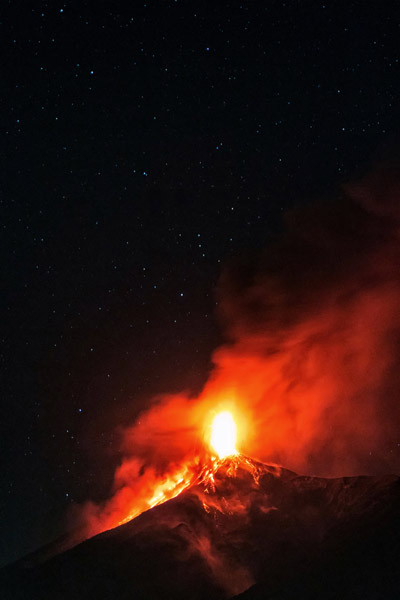Fuego Volcano: What’s going on?
“The reason why the February eruptions seemed stronger was basically wind direction blowing from west to northeast,” says volcanologist Gustavo Chigna at INSIVUMEH.
“Each volcano is an independent machine—nay, each vent and monticule is for the time being engaged in its own peculiar business, cooking as it were its special dish, which in due time is to be separately served.” This is a passage by Clarence Edward Dutton in his reporting on the “Geology of the High Plateaus of Utah” in 1880, but he might as well have been writing about the Fuego (Fire) Volcano in 2016.
Despite the big hoopla about the volcano’s activity on Feb. 9 and 10, when eruptions and roaring resembled a round-the-clock geological temper tantrum, it turns out these were not the volcano’s strongest eruptions in recent months, according to volcanologist Gustavo Chigna at INSIVUMEH (the National Institute of Seismology, Volcanology, Meteorology and Hydrology), which is part of the Ministry of Communication, Infrastructure and Housing.
Chigna says the February strombolian eruptions, a total of 18, were considerably small compared to the 15 on Jan. 3. “Strombolian activity is characterized by short-lived, explosive outbursts of pasty lava ejected a few tens of hundreds of meters into the air,” according to the Geology Department at San Diego State University.
“The reason why the February eruptions seemed stronger was basically wind direction blowing from west to northeast,” says Chigna. This expert explained that sound travel made the recent eruptions seem louder (even 20 kilometers away in a southwest direction) and stronger in a wider radius: windows shattered in villages like Santa Ana and San Bartolomé Becerra and other counties in Sacatepéquez, like San Miguel Dueñas (where small volcanic rocks fell on roofs), to Mixco, near Guatemala City, where some of the eruptions were also heard.
The Department of Geosciences at Oregon State University explains that the magma’s density and the rocks’ weight above it determine how high it will rise. “Bubbles form from the gas dissolved in the magma” and exert enough pressure to cause an eruption (like air bubbles in syrup or a soda).
INSIVUMEH reported similar eruptions on Oct. 15 and Dec. 15. Chigna says the October eruption was also stronger by far than last month’s events because Fuego had seven pyroclastic flows, whereas the February eruptions only had one. The U.S. Geological Service (USGS) describes a pyroclastic flow as containing “a high-density of hot lava blocks, pumice, ash and volcanic gas,” which move “at very high speed down volcanic slopes.”
Explosions and subsequent eruptions occur when gas inside the volcano comes in contact with humidity. Pressure builds up and the explosion follows upward and sideways in the crater. According to the USGS, “the rocks and gas inside pyroclastic flows are generally between 200°C and 700°C (390-1300°F), [and] can ignite fires.” The gases and hot ash can also be deadly or cause serious injury.
On Feb. 19, Fuego was active again with 13 weak and five moderate explosions, which spread ash only over itself, and a 150-meter long lava flow. INSIVUMEH, which compared Fuego’s roaring to an airplane’s turbine, monitors the volcanic activity daily. Fuego is one of Guatemala’s three active volcanoes. Another 30 remain dormant.
Click here for updates from INSIVUMEH
Click here for streaming satellite images
REVUE article by Julie López

Saw it on news. Few weeks ago I was watching a movie about a volcano. It is strange how I see and read everywhere about volcanoes. I am not planing to go anywhere, no trip so I don’t have to be scared. Right?
Oh please, if you want to be scared of your own shadow be my guest. The article has been very clear that this recent volcanic activity is much less than previous activity, the only difference has been the wind direction.
And even should there be a huge volcanic eruption tomorrow, well hard luck, or s*d’s law.